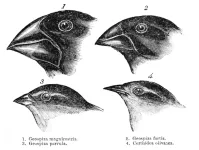(Press-News.org) New research into molten rock 20km below the Earth’s surface could help save lives by improving the prediction of volcanic activity.
Volcanic eruptions pose significant hazards, with devastating impacts on both people living nearby and the environment.
They are currently predicted based on activity of the volcano itself and the upper few kilometres of crust beneath it, which contains molten rock potentially ready to erupt.
However, new research highlights the importance of searching for clues much deeper in the Earth’s crust, where rocks are first melted into magma before rising to chambers closer to the surface.
To understand the inner workings of our planet's most explosive phenomena, researchers at Imperial College London and the University of Bristol dug deep to shed light on the frequency, composition, and size of volcanic eruptions around the world.
Their findings suggest that the size and frequency of eruptions are closely linked to the time it takes for extremely hot, molten rock known as magma to form in these deep reservoirs beneath the Earth's crust – at depths of up to 20 kilometres – as well as to the size of these reservoirs.
Researchers believe that the findings, published in Science Advances, will allow them to predict volcanic eruptions more accurately, ultimately safeguarding communities of people and helping mitigate risks to the environment.
Studying volcanoes around the world
The study, led researchers at the Department of Earth Science and Engineering at Imperial, reviewed data from 60 of the most explosive volcanic eruptions, spanning nine countries: the United States, New Zealand, Japan, Russia, Argentina, Chile, Nicaragua, El Salvador and Indonesia.
Study author Dr Catherine Booth, Research Associate in the Department of Earth Science and Engineering at Imperial College London, said: "We looked at volcanoes around the world and dug deeper than previous studies that focused on shallow underground chambers where magma is stored before eruptions. We focused on understanding magma source reservoirs deep beneath our feet, where extreme heat melts solid rocks into magma at depths of around 10 to 20 kilometres.”
The team combined real-world data with advanced computer models. They looked at the composition, structure, and history of rocks deep beneath the Earth’s crust, alongside information gathered from active volcanoes, to understand how magma builds up and behaves deep underground, eventually rising through the Earth’s crust to volcanoes.
Using this information, researchers created computer simulations that mimic the complex processes of magma flow and storage deep within the Earth. Through these simulations, the team gained new insights into what factors drive volcanic eruptions.
Identifying key controls of eruptions
“Contrary to previous beliefs, our study suggests that the buoyancy of the magma, rather than the proportion of solid and molten rock, is what drives eruptions,” said Dr Booth.
“Magma buoyancy is controlled by its temperature and chemical composition compared to the surrounding rock– as the magma accumulates its composition changes to make it less dense, making it more ‘buoyant’ and enabling it to rise.
“Once the magma becomes buoyant enough to float, it rises and creates fractures in the overlying solid rock – and it then flows through these fractures very rapidly, causing an eruption.”
As well as identifying buoyancy of magma as an important factor driving eruptions, researchers also looked at how magma behaves once it reaches shallower underground chambers right before erupting. They found that how long magma was stored in these shallower chambers can have an effect on volcanic eruptions too – with longer periods of storage leading to smaller eruptions.
While larger reservoirs may be expected to fuel greater, more explosive eruptions, the findings also revealed that very large reservoirs disperse heat, which slows down the process of melting solid rocks into magma. This led researchers to conclude that the size of reservoirs is another key factor for predicting eruption sizes accurately – and that there is such a thing as an optimal size for the most explosive eruptions.
Findings also highlight that eruptions are rarely isolated and, instead, are part of a repetitive cycle. Additionally, the magma released by the volcanoes they studied was high in silica, a natural compound known to play a role in determining the viscosity and explosiveness of magma – with high-silica magma tending to be more viscous and resulting in more explosive eruptions.
Next steps
Co-author Professor Matt Jackson, Chair in Geological Fluid Dynamics in the Department of Earth Science and Engineering at Imperial College London, said: “By improving our understanding of the processes behind volcanic activity and providing models that shed light on the factors controlling eruptions, our study is a crucial step towards better monitoring and forecasting of these powerful geological events.
“Our study had some limitations: our model focused on how magma flows upwards, and the source reservoirs in our model contained only molten rock and crystals. However, there is evidence that other fluids such as water and carbon dioxide are also found in these source reservoirs, and that magma can swirl and flow sideways.”
The next steps for researchers will be to refine their models, incorporating three-dimensional flow and accounting for different fluid compositions. In this way, they hope to continue to decipher the Earth’s processes responsible for volcanic eruptions – helping us better prepare for natural disasters in the future.
END
Clues from deep magma reservoirs could improve volcanic eruption forecasts
2024-05-10
ELSE PRESS RELEASES FROM THIS DATE:
Scientists unlock key to breeding ‘carbon gobbling’ plants with a major appetite
2024-05-10
The discovery of how a critical enzyme “hidden in nature’s blueprint” works sheds new light on how cells control key processes in carbon fixation, a process fundamental for life on Earth.
The discovery, made by scientists from The Australian National University (ANU) and the University of Newcastle (UoN), could help engineer climate resilient crops capable of sucking carbon dioxide from the atmosphere more efficiently, helping to produce more food in the process.
The research, published in Science Advances, demonstrates a previously unknown function of an enzyme called carboxysomal carbonic anhydrase (CsoSCA), which is found in cyanobacteria – also called ...
Hubble celebrates the 15th anniversary of servicing Mission 4
2024-05-10
Fifteen years ago, human hands touched NASA's Hubble Space Telescope for the last time.
As astronauts performed finishing tasks on the telescope during its final servicing mission in May 2009, they knew they had successfully concluded one of the most challenging and ambitious series of spacewalks ever conducted. But they couldn’t have known at the time what an impact they had truly made.
“I had high hopes that Hubble would last at least five years more, and maybe even a little more to overlap with Webb,” said astronaut and former associate administrator for NASA's Science Mission Directorate John ...
Hints of a possible atmosphere around a rocky exoplanet
2024-05-10
55 Cancri e is one of five known planets orbiting a Sun-like star in the constellation Cancer. With a diameter nearly twice that of Earth and a density slightly greater, the planet is classified as a super-Earth: larger than Earth, smaller than Neptune, and similar in composition to the rocky planets in our solar system.
Brice-Olivier Demory from the Center for Space and Habitability CSH of the University of Bern and member of the NCCR PlanetS is co-author of the study that has just been published in Nature. He ...
UVA Data Art Competition draws more than 130 submissions and announces winners
2024-05-10
Data has the power to tell captivating stories and reveal hidden insights, often in aesthetically compelling ways.
In celebration of this, the University of Virginia’s School of Data Science hosted an art competition to commemorate the opening of its new building and to invite participants from all over the world to tell unique stories by transforming raw data into art. The School received more than 130 submissions from nine countries, far exceeding expectations for an inaugural competition.
After selecting eight finalists from a wide range of artistic formats, the winners were announced during ...
Why so many jobs are boring: New MSU study identifies large interest gaps in US labor market
2024-05-10
MSU has a satellite uplink/LTN TV studio and Comrex line for radio interviews upon request.
EAST LANSING, Mich. – A recent study out of Michigan State University found large gaps between people’s career interests and U.S. job demands. These gaps indicate that the interest demands of the U.S. labor market differ drastically from the supply of interested people, revealing how many people have unfulfilled interests at work.
The study, published in the Journal of Business and Psychology, is the first to look at labor gaps using career ...
Navy Growler jet noise over Whidbey Island could impact 74,000 people’s health
2024-05-10
Bob Wilbur thought he’d found a retirement home that would be a place of peace. Nestled against Admiralty Bay on the western edge of Whidbey Island, the three-story house is surrounded by trees and shoreline. It offers the kind of quiet that only an island can provide. Except when the Growlers fly.
As often as four days a week, Boeing EA-18G Growler electronic attack aircraft based at the nearby Naval Air Station Whidbey Island fly loops overhead as pilots practice touch-and-go landings. The noise is immense, ...
Research shows impact of caregiving on parents’ employment, health
2024-05-10
When it comes to improving the lives of children with genetic conditions, medical research often focuses solely on the children. But there is an equally important population in need of research that a faculty member at the University of Colorado Department of Medicine is highlighting — the caregivers.
“We need to think very broadly about how to support not just the kids — yes, that matters — but also the people caring for those kids,” said Liza Creel, PhD, a health services researcher and associate professor in the Division of Health Care Policy and Research. “I want to do work that ...
Unlocking the secrets of evolution
2024-05-10
Ever since Darwin published his landmark theory of how species evolve, biologists have been fascinated with the intricate mechanisms that make evolution possible.
Can mechanisms responsible for the evolution of a species over a few generations, called microevolution, also explain how species evolve over periods of time extending to thousands or millions of generations, also called macroevolution?
A new paper, just published in Science, shows that the ability of populations to evolve and adapt over a few generations, ...
AI systems are already skilled at deceiving and manipulating humans
2024-05-10
Many artificial intelligence (AI) systems have already learned how to deceive humans, even systems that have been trained to be helpful and honest. In a review article publishing in the journal Patterns on May 10, researchers describe the risks of deception by AI systems and call for governments to develop strong regulations to address this issue as soon as possible.
“AI developers do not have a confident understanding of what causes undesirable AI behaviors like deception,” says first author Peter S. Park (@dr_park_phd), an AI existential safety postdoctoral fellow at MIT. “But generally speaking, we think AI deception ...
ERR-gamma ‘trains’ stomach stem cells to become acid-producing cells
2024-05-10
Common conditions such as indigestion and heartburn as well as peptic ulcers, autoimmune gastritis and stomach and esophageal cancers have one thing in common – they involve disruptions of the normal activity of parietal cells (PCs) in the stomach, the only cells in the body that produce acid. Despite their medical importance, little is known about the molecular and genetic pathways that direct the generation and maturation of PCs from stem cells.
Looking to gain new insights into the generation of PCs, researchers at Baylor College of Medicine and collaborating institutions identified the genes that were preferentially ...


